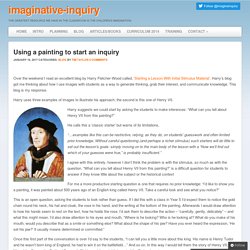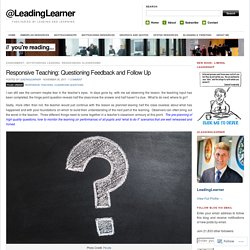

Questions worth asking. I think decent questioning lies at the heart of learning.

With Daniel Willingham’s premise that “memory is the residue of thought” in mind, my lesson planning keeps coming back to the same, central idea: ask students questions that get them thinking about the things I want them to remember. There are different ways of approaching questioning. One is by asking questions that prompt students to think about things deeply, carefully, thoroughly. Another is by asking them regularly. Questions to prompt thought With regard to thinking deeply, I was fortunate enough to attend some Teach Like A Champion training at the end of last year, where we explored using “Front The Writing.”
An example of this is demonstrated by a student in my Year 7 class. Mrs Hedley is shocked, annoyed, upset, fear. Beneath this initial response is our discussion tracker, a small box where students make notes based on paired and whole class discussion. Mrs Hedley feels worried and concerned he will die like his father. Getting started with Assessment for Learning. Glossary Active learning Learning which engages students and challenges their thinking, using a variety of activities. Assessment for learning Essential teaching strategies during learning to help teachers and students evaluate progress in terms of understanding and skills acquisition, providing guidance and feedback for subsequent teaching and learning. Closed question A question that can be answered with either a single word (usually ‘yes’ or ‘no’) or a short phrase and the choice of answers is limited.
Cold calling Questioning technique in which the teacher selects a learner at random to answer a question, instead of learners putting up their hands to answer a question. Critical thinking The ability, underlying all rational discourse and enquiry, to assess and evaluate analytically particular assertions or concepts in the light of either evidence or wider contexts. Ego-specific feedback Feedback to the learner that focuses on their personal qualities. This much I know about…overcoming my prejudices to the benefit of my students. I have been a teacher for 29 years, a Headteacher for 14 years and, at the age of 53, this much I know about overcoming my prejudices to the benefit of my students Multiple choice questions have always been abhorrent to me.

My prejudice against MCQs is both instinctual and ideological, I think. I have forever associated MCQs with a functional approach to education. What use would a liberal like me ever have for the A, B, C or D approach to teaching and learning? The root of my prejudice is, like all prejudices, ignorance. I like listening to experts. The results have been hugely useful. Writing effective MCQs is not easy. Every school needs someone who can help you access the evidence-base. A great brief guide can be found here. ‘A review of multiple choice item-writing for classroom assessment’ is available here. A general guide for teachers on test writing, with a great section on MCQs can be accessed here. Like this: Like Loading... Headteacher in York. Using a painting to start an inquiry. Over the weekend I read an excellent blog by Harry Fletcher-Wood called, ‘Starting a Lesson With Initial Stimulus Material’.

Harry’s blog got me thinking about how I use images with students as a way to generate thinking, grab their interest, and communicate knowledge. This blog is my response. Harry uses three examples of images to illustrate his approach; the second is this one of Henry VII. Harry suggests we could start by asking the students to make inferences: “What can you tell about Henry VII from this painting?” He calls this a ‘classic starter’ but warns of its limitations, “…examples like this can be restrictive, relying, as they do, on students’ guesswork and often limited prior knowledge. I agree with this entirely, however I don’t think the problem is with the stimulus, so much as with the question.
This is an open question, asking the students to look rather than guess. For me this inquiry has five parts: Each step has a specific aim: Responsive Teaching: Questioning Feedback and Follow Up. I can still see the concern maybe fear in the teacher’s eyes.

In days gone by, with me sat observing the lesson; the teaching input has been completed, the hinge point question reveals half the class know the answer and half haven’t a clue. What to do next; where to go? Sadly, more often than not, the teacher would just continue with the lesson as planned leaving half the class clueless about what has happened and with poor foundations on which to build their understanding of the next part of the learning. Observers can often bring out the worst in the teacher. Three different things need to come together in a teacher’s classroom armoury at this point. Each year I have the pleasure of spending a couple of hours working with trainee teachers. Key to the session is stressing the “logical development of knowledge”; what will you teach pupils and in what order and why?